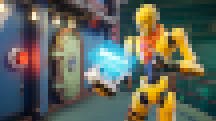Through the many rapid changes in technology we’ve seen over the years, only a handful appear to have real sticking power and truly transform our way of life. Real-time interactive 3D may be that next transformative technology. In terms of its impact on learning, we have only scratched the surface, with new opportunities emerging from secondary to higher education.
EdSurge recently talked with Linda Sellheim, Education Lead at Epic Games, to learn just how much interactive 3D is changing education and a number of other industries. Here, she explains how this immersive technology is reshaping the very nature of work.
EdSurge: What is interactive 3D? How did it become so popular?
Sellheim: Interactive 3D is the ability to interact with the digital world the same way you do with the real world. These experiences can take many forms, from dynamic web-based content to immersive VR, AR or MR experiences. You know those realistic simulations of storms you see on the Weather Channel? That’s interactive 3D.
The tech that powers all of this is called real-time rendering. That’s what artists use to visualize 3D environments, characters and content in a manner that feels instantaneous to anyone who interacts with it.
In terms of its popularity, let’s look at how an animated film is created, for example. Usually, it takes a computer days, weeks, or even months to render an entire film. To further complicate things, if an artist wants to make even the smallest change, the entire thing has to be re-rendered. With interactive real-time graphics, the visuals are rendered and displayed almost instantly, which, in turn, makes it much easier for teams to iterate and make changes. This is revolutionary for people.

And because interactive 3D technology has proven so flexible, it’s being integrated across industries, from media and entertainment to retail, advertising, healthcare, manufacturing, automotive, urban planning, engineering, design and more at a rapid rate. Someday soon, everyone entering the workforce will either consume, create or interact with this tech. That’s why we are encouraging educators to start preparing students now.
How does a technological leap like this change the job market?
So much of what you see on a day-to-day basis is 3D or CGI, and most people don’t even realize it. For example, 90 percent of the cars you see in commercials or print ads are not real—they’re 3D recreations. Same goes for sneakers, furniture and fashion. During the COVID-19 pandemic, people have even been buying homes they haven’t been to thanks to 3D virtual tours.
There are many opportunities, in all career sectors, for young people who learn this technology. They can become leaders and innovators very quickly. The data supports this. Last year, we commissioned Burning Glass to identify the types of 3D skills needed in the workplace. They found that jobs requiring real-time 3D skills are growing 601 percent faster than the job market overall, and pay 57 percent above the average advertised salary.
But many teachers ask: “What kind of jobs can students who learn 3D do?” To which I say: “How much time do you have?” 3D impacts almost every industry. One example I like to use is surgical simulation in healthcare. With interactive 3D, we can teach doctors the processes and experiences related to surgery without actually having to cut someone open. If you can imagine it, you can probably make it in 3D. The possibilities are endless.

How can a teacher get students up to speed in interactive 3D?
Young people have been playing video games and living their lives online since birth. The digital world feels totally natural to them. So, now it’s about taking them from player to creator. Many students have skills they don’t even realize are skills because nobody has shown them what they can do with them.
At Epic, my team is focused on creating free, easy-to-use resources to help teachers bring these lessons into the classroom. It’s very important to understand that you do not have to be an expert—or even in a technical sector of the academic landscape—to teach these tools. We have created the content, assets and lesson plans to get teachers up to speed, with different lessons to choose from depending on what you or your students are drawn to. And best of all, the lesson plans were created by teachers who have actually implemented them in real classrooms.
One popular lesson plan is our “Hour of Code” coursework, which is designed to teach coding skills to people of all ages in a fun, interactive way. We also have lesson plans built around Fortnite Creative, which teens love. Although most of the lessons have a gaming theme, they do not contain violence, guns or anything problematic like that. And they aren’t just for computer science students; they can be used in art classes too. Imagine building a history museum in Unreal Engine and having students populate the displays. That's what some classes are doing.
I would encourage interested educators to read this blog post that includes the new Creator’s Field Guide to Emerging Careers in Interactive 3D. In the guide, we look at eight careers and the skills needed to get into them. The guide also includes an entry-level taxonomy of Unreal Engine skills to help teachers get started.

Where does interactive 3D fit into a traditional K-12 curriculum?
It fits in everywhere! We are living in an immersive world. Five years ago, people wouldn’t have expected interactive 3D to be used in a lot of the spaces we’ve talked about, but this is what’s next. And five years down the road, we’re going to see students coming up with ideas, solving problems and creating things we haven’t even begun to imagine.
It just takes creative teachers to make the leap and get their students engaged. With lesson plans built around video games, for instance, teachers can surprise and delight students by bringing something they love into the classroom. And, because students are already familiar with the digital world, they adapt quickly to the tools. They absorb information in many different ways, but the majority of the population are visual learners. How fun would it be to teach geography in Fortnite Creative? Why can’t students turn in interactive 3D projects instead of writing a paper? The more tools we can give them to succeed, the better.
We invite all educators to check out resources such as Unreal Engine's Secondary Education Lesson Plans and Games For Change. And I want to reiterate: You don’t have to be an expert to do any of this. You just need to know the basics, and we’re here to help. Let your students become the experts!

What are you creating next for teachers?
We have a new campaign called Unreal Futures, which is a learning series that provides a clear pathway to exciting interactive 3D careers across a variety of industries. The first of the series, Unreal Futures: Careers in Advertising, provides tools to understand where the industry is heading and how to create your first 3D advertisement in Unreal Engine. We are also working on one dedicated to fashion now.

![6 Ways to Prepare Students for the Future with Interactive 3D [Infographic]](https://edsurge.imgix.net/static_assets/blue_green_gradient.jpg?auto=compress%2Cformat&w=360&h=190&fit=crop&blur=200&px=16&mono=E4E6E9)
![6 Ways to Prepare Students for the Future with Interactive 3D [Infographic]](https://edsurge.imgix.net/static_assets/blue_green_gradient.jpg?auto=compress%2Cformat&w=190&h=190&fit=crop&blur=200&px=16&mono=E4E6E9)